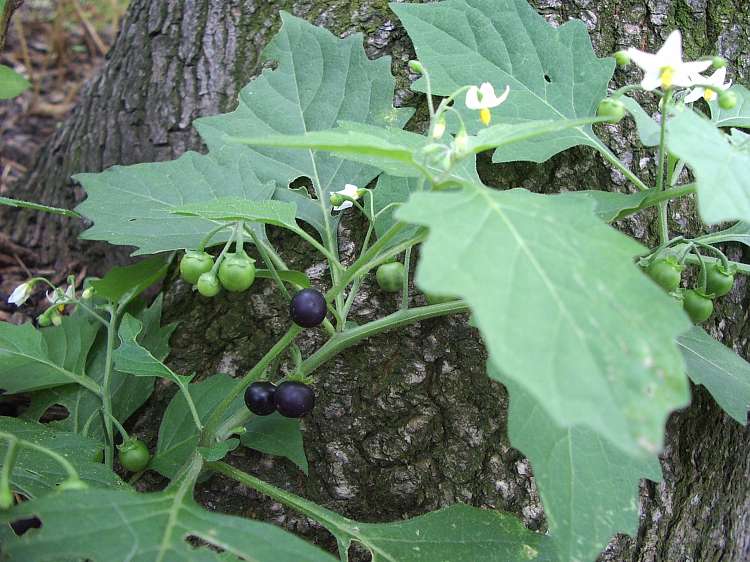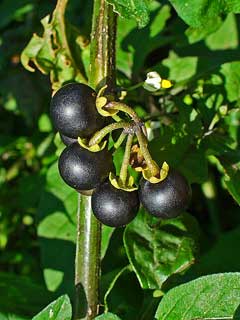
Also known as hounds berry, black nightshade is an annual or short-lived perennial native to wooded areas and disturbed sites of Europe and Asia but is found in the United States primarily along the West Coast. It is a member of the nightshade family, Solanaceae, that also includes peppers, potatoes, and eggplant. Plants grow up to three feet in height and have erect, slender, purplish stems that can become woody with age. Low growing branches of young plants hug the ground at first but shoot upward just before flowering. The oval-shaped alternate leaves are 1.5-4″ long, are green on the upper sides and purplish on the lower side when young but become dark green and sometimes develop toothed margins as they mature. When temperatures are warm, clusters of 3-12 star-shaped flowers with 4-5 white petals and yellow anthers are produced. Each flower is about 1″ long and is attractive to pollinating insects and bees. The green berries that follow turn black as they age, contain 15 to 60 seeds, and are eaten by birds that spread the seeds. The root system is a fibrous, shallow taproot. Black nightshade is toxic to humans and livestock but historically has been specially prepared and used as food and medicine. In more modern times some cultivars have been developed that produce edible ripe berries but don’t eat the berries of any nightshade in the wild! In some areas, black nightshade is considered a serious horticultural weed. The genus name, Solanum, is from the Latin word solamen, meaning comforting or soothing, referring to the medicinal qualities of some species. The specific epithet , nigrum, is the Latin word meaning black, and refers to the color of the berries. Photo Credit Harald-Hubich-Wikipedia

Type: Annual or short-lived perennial or shrub
Outstanding Feature: Berries
Form: Vase-shaped
Growth Rate: Rapid
Bloom: Clusters of star-shaped flowers with white petals and yellow stamens in summer
Size: 1-4.5′ H x .3-3′ W
Light:Full sun
Soil: Average, medium moist, ell-drained, slightly acidic; drought resistant when established
Hardiness: Zones 10-11
Care: Low maintenance; may need to be restricted
Pests and Diseases: Susceptiable to damage by red spider mites, thrips, whiteflies, aphids, flea beetles, aterpillars and slugs.
Propagation: Seed
Outstanding Selections:
‘Red Makoi’ (red berries)
Photo Credit: Llez Wikimedia Commons